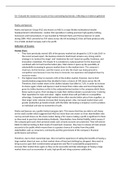D1- Evaluate the reasons for success of two contrasting businesses, reflecting on evidence gathered
Marks and Spencer
Marks and Spencer Group (PLC) also known as M&S is a major British multinational retailer
headquartered in Westminster, London that specialises in selling premium high-quality clothing,
homeware and food products. It was founded by Michael Marks and Thomas Spencer in Leeds
during 1884. M&S currently has 959 stores across the UK including 615 that sell food products only.
It is a Public Limited Company and is for-profit.
Indicators of Success:
Market Share
They have previously owned 10% of the grocery market but dropped to 3.2% in July 2019. In
the recent annual report, the business states its food brand remains very strong and its
strategy is to ‘protect the magic’ and ‘modernise the rest’ based on quality, freshness, and
innovation credentials. The Ocado JV is considered a natural partner for the brand and
combined with its food transformation plan, M&S claims it opens up the possibility of
substantially increasing its grocery market share in the medium term. The company’s
chairman, Archie Norman, said the reason as to why the chain was losing ground to
competitors was because it was too slow to innovate, too expensive and weighed down by
excessive waste.
The highest share they’ve owned is 43% of the clothes market. However, due to their
transformation programme they decided to have a closure of 100 stores across the UK.
Therefore, their market share in the clothes industry has fallen to 7.6%. In order to increase
its shares again; Marks and Spencer need to boost their online sales and most importantly
grow its clothes business as this is the underperformed section in the company which Steve
Rowe wants to grow. Their strategy to make their clothes industry successful is by ‘restoring
their reputation for style and value.’ Higher market share will put M&S at a competitive
advantage. Companies with high market share often receive better prices from suppliers, as
their larger order volumes increase their buying power. Also, increased market share and
greater production go hand-in-hand, with the latter decreasing a company's cost to produce
an individual unit due to economies of scale.
Marks and Spencer are a public limited company (plc). This means that they are able to sell shares
on the stock market which suggests that M&S has more than one owner as it has shareholders who
can buy and sell shares on the stock market. Being a PLC means making a profit is significant to them
as they need to pay their shareholders dividends. Shareholders have limited liability which means if
the company gets sued, their personal assets such as bank accounts are protected. They will only be
liable for debt according to their levels of investment. However, they have to release all main annual
accounts to the public which means there is a greater chance of scrutiny from the public
stakeholders such as consumers, community and the government of the company’s financial
performance and actions.
Therefore, due to their ownership type, they’ve had the experience of taking the benefits of having a
large market share but now, as their market share of food and clothing has dropped, they need to
bring success upon their transformation programme and Plan A sustainability programme to
increase their market share again so they can be successful and take advantages of having a large
market share such as economies of scale, high profit and rising customer satisfaction.
, In the hope of making Marks and Spencer ‘special’ again, M&S says it has strengthened the
communication of value in stores and it reports encouraging transaction. In the current year, a series
of workstreams have been designed to simplify supply relationships, to reduce costs and increase
the pace of innovation as these will support the company’s work to build value.
Profit
Profit: 31st March 2018
Group revenue- £10.7 billion
• £5.9 billion generated from Food
• £3.7 billion generated from Clothing and Home
Group Profit before Tax- £66.8 million
Profit: 30th March 2019
Group revenue- £10.4 billion
• £5.9 billion generated from Food
• £3.5 billion generated from Clothing and Home
Group Profit before Tax- £84.6 million
As the table shows, it is clearly evident that Marks and Spencer’s revenue from Food, Clothing &
Home has remained pretty much similar over the two years. The Group Revenue has decreased from
£10.7 billion to £10.4 billion. However, the Group Profit before Tax has increased from £66.8 million
in 2018 to £84.6 million in 2019. Overall, since 2018, the company has not been very successful in
terms of revenue because it dropped since 2018 as there was a change of -3.0%. The decline in like-
for-likes in M&S’ two core departments were driven by a 0.6% decline in total food sales and a 3.6%
drop in total clothing & home sales.They are currently under a major transformation scheme, of
which the chief executive, Steve Rowe, concluded that the decrease in sales was due to inconsistent
performance because of the store closure programme. However, to improve their sales they are
going to bankroll its £750 million joint venture deal with Ocado to sell food online in the attempt to
also modernise the business. Marks and Spencer have not been very successful for the past couple
of years, but they are going to remain on track with their transformation to making M&S ‘special’
and successful again.




